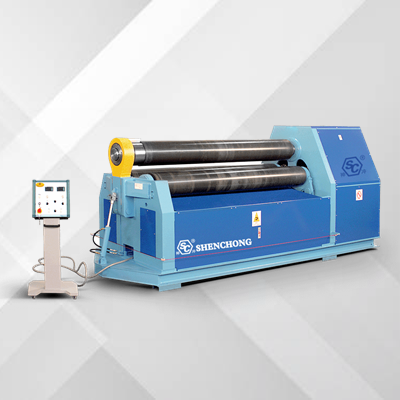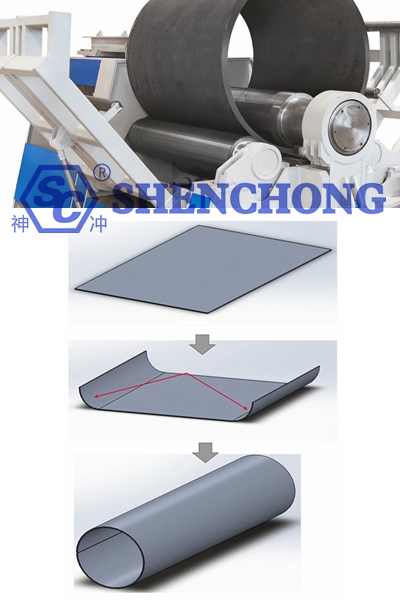
The sheet metal plate rolling radius refers to the radius of the circle formed by the bending of the plate when the plate is rolled using a plate rolling machine. The calculation and selection of the rolling radius is crucial to the operation of the plate rolling machine. It is necessary to ensure the rolling effect while considering the equipment's load capacity, material performance, and operational feasibility. An appropriate rolling radius can ensure a smooth rolling process and avoid material damage or equipment overload.

In the operation of the plate rolling machine, the plate rolling radius refers to the radius of the circle formed after the plate is bent. This radius determines the degree of material bending and the final forming effect.
If the rolling radius is too small, the plate may be excessively deformed or even broken during the rolling process; if the radius is too large, it may cause the forming time to be too long and the process to be uneconomical.
It is a key parameter in the rolling process and directly affects the quality and process requirements of the forming. Choosing a suitable rolling radius is very important to ensure the rolling quality, avoid material damage and improve production efficiency.
When choosing the plate rolling radius, you need to consider the material thickness, type, yield strength, equipment performance and forming requirements. In most cases, you can choose the appropriate rolling radius based on the thickness and material properties of the sheet to ensure that there are no problems such as material cracking and creases during the rolling process, while meeting the quality requirements of the final workpiece.
Usually, the plate rolling radius is proportional to the sheet thickness. In theory, the curling radius should not be less than a certain multiple of the sheet thickness, otherwise it may cause excessive plastic deformation of the sheet and affect the forming quality.
R≥K⋅t
Where:
- R is the radius of the roll.
- K is a constant, usually between 6 and 10, and the specific value varies depending on the type of material, the type of roll rolling machine and the process requirements.
- t is the thickness of the plate.
For example, if the plate thickness is 10 mm, the selected roll radius should usually be between 60 mm and 100 mm.
Different materials have different yield strengths and ductility, which will also affect the selected rolling radius:
- Low carbon steel: Usually easier to form, the rolling radius can be relatively small.
- Stainless steel and high-strength steel: These materials have higher yield strength and poor plasticity, requiring a larger rolling radius.
- Aluminum alloy: Although the yield strength is lower, the ductility of aluminum alloy is better, so the radius can be smaller.
The design, working method and operating accuracy of the plate rolling machine will also affect the selected rolling radius:
For common three-roller plate rolling machines, the rolling radius is usually determined by the specifications and maximum pressing capacity of the equipment, and thicker materials may require a larger radius.
The control of the four-roller plate rolling machine is more precise, so for some rolls that require high precision, a smaller rolling radius can be selected.
The quality of the workpiece after rolling is also an important factor to consider when choosing the rolling radius.
For example:
- High roundness requirements: If the roundness requirements are very strict, it is best to choose a larger rolling radius to avoid irregular bending.
- High surface finish requirements: When rolling with a small radius, creases or other defects may appear on the surface of the sheet, especially on materials with higher hardness. At this time, appropriately increasing the radius can help reduce this problem.
During the rolling process, the sheet will undergo plastic deformation. Too small a rolling radius may cause local cracks or ruptures in the sheet, especially for thicker or harder materials. Therefore, choosing a larger radius can reduce the concentration of force on the material.
- Thinner sheets: You can choose a smaller rolling radius, usually 6 to 8 times the thickness of the sheet.
- Thicker sheets: You need to choose a larger radius, usually 8 to 10 times the thickness of the sheet.
- Harder materials: If the yield strength of the material is high (such as stainless steel, high-strength steel, etc.), a larger curling radius should be selected to avoid the material becoming brittle and breaking.
- Softer materials: If the material is softer (such as aluminum alloy, low-carbon steel, etc.), a smaller radius can be appropriately selected.

Assumption:
The plate thickness is t=12mm
The material is low carbon steel (yield strength is about 250 MPa)
Then according to the empirical formula: R≥K·t
Assuming the constant K=8 (applicable to low carbon steel), the minimum plate rolling radius is:
R≥8·12mm=96mm
Therefore, it is more reasonable to choose a rolling radius of about 100 mm.
These calculation methods provide a theoretical reference, and the specific rolling operation still needs to be adjusted in combination with the characteristics of the actual equipment and materials. In practical applications, in addition to theoretical calculations, factors such as material elasticity, surface treatment, and adjustment accuracy of the plate rolling machine need to be considered.
- Material type and yield strength: The greater the yield strength of the material (such as stainless steel, high-strength steel), the larger the rolling radius is usually required to avoid cracks or breaks in the material during the rolling process.
- Plate thickness: Thicker plates require a larger rolling radius to reduce deformation stress.
- Plate rolling machine type and capacity: Different types of plate rolling machines (such as three-roller machines, four-roller machines) have different rolling capabilities. Some machines may be able to withstand a smaller radius, while other machines may require a larger radius.
- Finished product requirements: If the finished product requires high roundness and smooth surface, a larger rolling radius may be required.
In the actual rolling process, the rolling radius is often not fixed, but needs to be adjusted at multiple stages:
- Initial rolling: The plate will undergo the initial bending, at which time the rolling radius is larger.
- Subsequent rolling: By gradually reducing the degree of bending, the desired round shape is finally formed.
Usually, in order to reduce the burden on the equipment and ensure the quality of rolling, the rolling radius will be selected within a certain range to avoid material damage caused by too small a radius.
- Thinner sheet (e.g. 3 mm): Select a curling radius of 18 mm to 24 mm (i.e. 6 to 8 times the sheet thickness).
- Medium-thick sheet (e.g. 10 mm): Select a curling radius of 60 mm to 100 mm (i.e. 6 to 10 times the sheet thickness).
- Thicker sheet (e.g. 20 mm): Select a curling radius of 120 mm to 200 mm.
Plate rolling radius is an important parameter in the sheet rolling process. A suitable curling radius can ensure the quality of the roll and improve production efficiency. By properly selecting the plate rolling radius, material breakage or uneven deformation can be avoided, ensuring that the final formed workpiece meets the design requirements. In actual operation, the thickness, type, yield strength of the material and the working capacity of the equipment need to be comprehensively considered when selecting the curling radius.